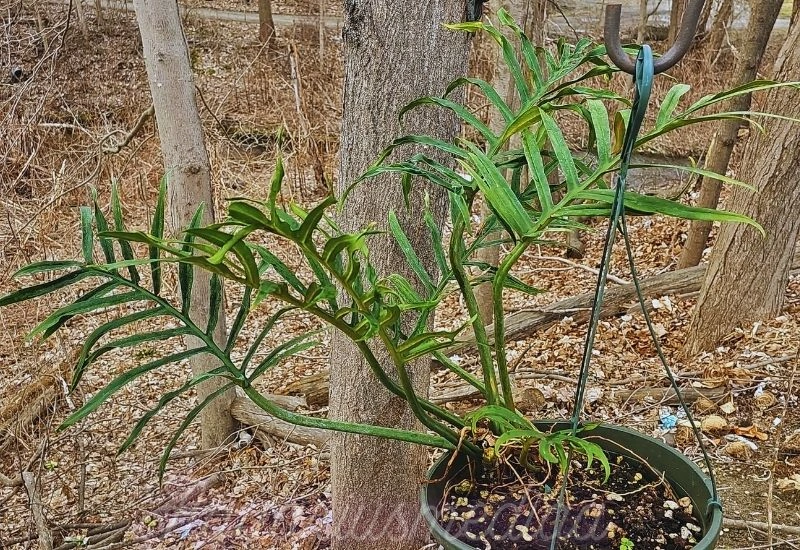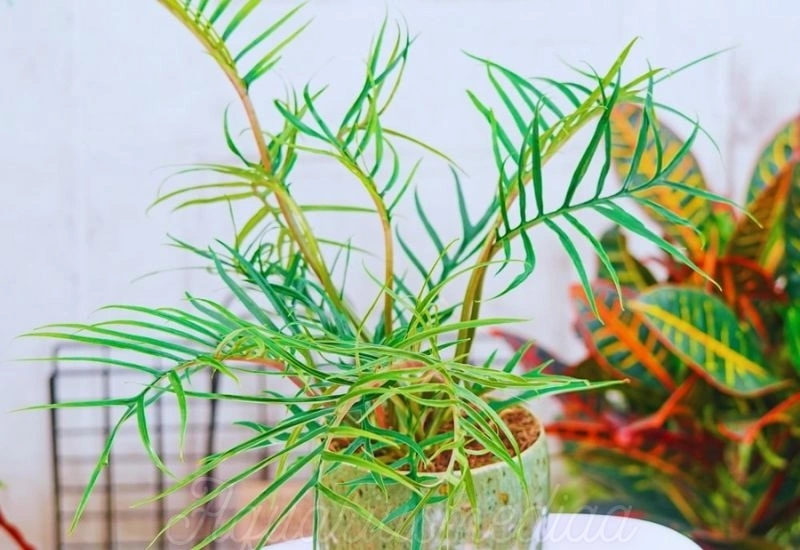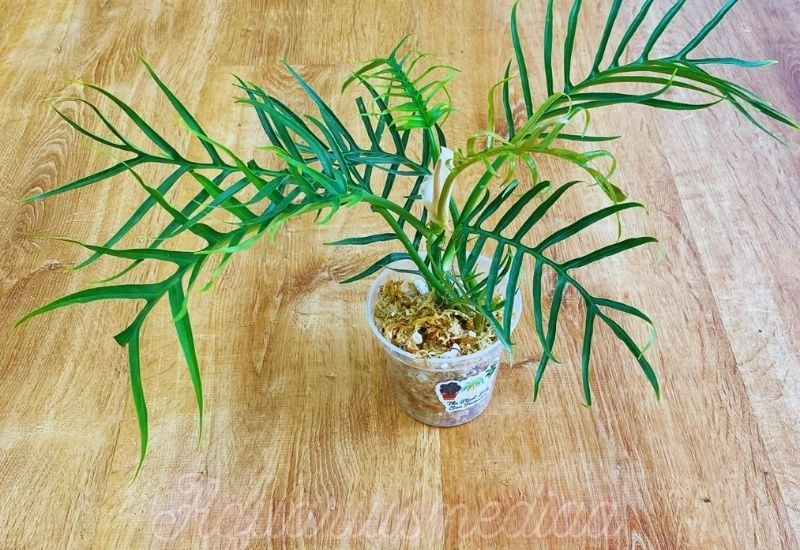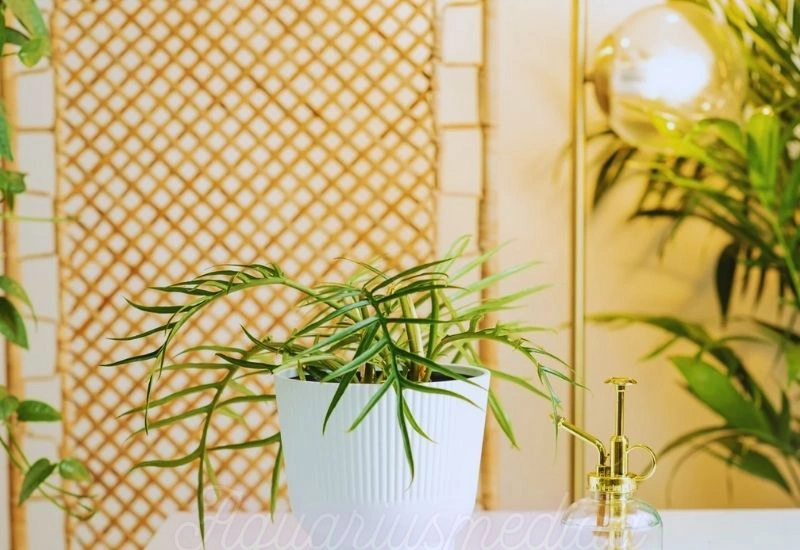In this blog post, you’re going to learn how to easily propagate and care for Philodendron tortum.
This is a comprehensive guide covering reliable information about different aspects of this cultivated variety.
In this post, I’ll cover:
- Interesting Facts
- Propagation
- Repotting
- Care
And
- Solutions to Common Problems
So, if you are looking to propagate and care for Philodendron tortum, this guide is for you.
Fun Facts
| Common Name | Corkscrew Philodendron |
| Botanical Name | Philodendron Tortum |
| Family | Araceae |
| Plant Type | Climbing Herb |
| Fruit | Small berry like |
| Mature Size | Height 6-feet, width 2-feet |
| Sun Exposure | Bright, indirect sunlight |
| Soil Type | Well-draining potting mix |
| Soil pH | 6.1-7.3 |
| Native Area | Brazil (Amazonas) |
| Toxic | Contains a toxin called calcium oxalate |
| Growth | Slow growing, But optimum growth in humidity range of 50%-70% |
Philodendron tortum belongs to the Araceae family, specifically of the philodendron genus with the species name tortum. It has several similarities with the other members of its genus, for example, in growth habits (climbing) and requiring humidity. It is one of the most recognized species because of its ability to develop in regions with low light, such as homes, offices, working spaces, etc.
Corkscrew Philodendron mainly grows during the period when temperatures and humidity are high, during a warm summer season. When growing actively, the philodendron tortum starts to produce new leaves and stems. There is also a slower rate of growth in winter, and most of the plants undergo the dormancy stage at this time.
Flowering and Fruits in Philodendron Forum
This plant bears typical flowers of the Araceae family. Flowers are characterized by a spadix (a small spike of flowers) and a spathe (a leaf-like bract). The spathe is generally green or white and can be semi-circular, covering the spadix. The flowers are small and relatively hidden from view. Blooming in the Philodendron tortum is relatively uncommon in an indoor environment.
The fruits are small berry-like, and the seeds are inside them. These fruits help in the distribution of seeds, assisting the species in reproduction. The fruit structure is not exciting, and the plant is more famous for its leaves than the fruiting structure.
The leaves are long and narrow, with segments that make them appear to be fern-type plants. The leaves of the plant are dark green in color and glossy in nature, which adds more to the overall beauty of the plant.1
Benefits
Philodendron tortum has the following major benefits:
Aesthetic Appeal
This plant has an impressive and pleasing sight. It is valuable for the decor of homes, offices, and other types of interiors.
Air Purification
Like other philodendrons, Philodendron tortum has the ability to purify the air. The plant can absorb most of the interior pollutants such as formalin, benzene, and chloroform. This improves the quality of air inside a home or an office.
The presence of Corkscrew Philodendron in your working space can increase the quality, promote well-being and decrease the probabilities of getting respiratory diseases.
Low Maintenance
For Philodendron tortum, a specific soil medium is not so critical, so it is good for both beginner and experienced plant lovers. It emerges in darkness and can grow in places where there is very low light intensity; it does not demand much water and can survive in dry areas.
Due to its slow rate of growth, it requires less repotting or pruning, making the plant very easy to maintain.
Stress Reduction
Several researchers have established that indoor plants have psychological benefits, such as lowering stress. This effect can be achievable when you have a Philodendron tortum in your living or working space.
Versatility in Decor
This plant’s appearance is special and shiny, so it fits into most interior designs. Regardless of whether it is put in a contemporary, sleek apartment or in a more conventional one, this plant will fit most locations.
The flexibility of it to the variable light conditions makes it easy to position it whether in well illuminated areas such as the windows or less illuminated areas such as the corner.
Summary
The plant Philodendron tortum has multiple advantages, including its ornamental value, its ability to clean the air, easy care, and the effects of the plant on the human psyche.
It suits any kind of decoration, and due to its capability to accomodate in different conditions it is an advantage to have it in house or any indoor environment.
Uses
Some common and worth-noting uses of this plant are described below:
Indoor Decoration
Philodendron tortum is recommended for its aesthetic purpose and is often used for interior design.
It can be utilized in living spaces, workspaces, and other interior zones, increasing their visual interest and contributing to the formation of a calm atmosphere. It can be put on the table or displayed on the shelf, or in the hanging basket.
Air Filtration
Indoor air purification by the Philodendron genus is also valid. It enhances the quality of air in interiors through the use of Philodendron tortum in their homes.
Office Plant
Plants can grow in poorly lit areas and do not need much attention; Philodendron tortum can become the office plant. It was evidenced that green plants in the interior construct positively affect workers by focused concentration and a calming feel.
Educational Tool
It is used for knowledge in schools, botanical gardens, and plant nurseries. Many instructors use this plant to guide students about plant morphology and adaptations of different categories in the kingdom Plantae.
Moreover, through undertaking research on Philodendron tortum, students and plant lovers will be able to have additional knowledge on botany.
Horticultural Therapy
Horticultural therapy simply involves the plant and engaging in gardening activities to enhance psychological and physiological health.
Because of the plant’s characteristics and versatility, horticultural therapists have found that Philodendron tortum is ideal for horticultural therapy programs. Interaction with it can help people feel soothing, free from stress and tiredness, and simply have fun.
Propagation

Gardeners propagate Philodendron tortum mostly through stem cutting. It can also be propagated through seeds, but it is less common and time-consuming. The preferred and probably the most efficient method is stem cutting because it helps in quick germination.2
Stem Cutting Propagation
To propagate Philodendron tortum via stem cuttings, follow these steps:
Select a Healthy Parent: Select an active Philodendron tortum with multiple well-developed healthy stems of good length.
Cut a Stem: Take a clean sharp knife or a pair of scissors and trim a small stem cutting of about 4-6 inch length. The cutting should have at least two nodes (the points where growth is initiated).
Prepare the Cutting: Trim off the lower part of the cutting to just one or two leaves at the top. It assists to prevent transpiration and directs the energy generated towards root creation.
Plant the Cutting: Place the cutting in a pot with appropriate planting soil.
Ensure Optimal Conditions: It is recommended to put the pot in a warm place that is humid and in indirect sunlight. Maintain the soil wet but not water logging.
Monitor and Care: Identify some signs of growth on the cutting. Shoots should start to grow within a few weeks, and new roots should be established. By the time a new root starts growing and the new leaves appear, it can be transplanted to a bigger pot.
Bonus Tip
f available, you can dip the end of the stem into a rooting hormone (in the form of a powder or gel). Even though this step is not mandatory, it is a good idea to perform it for the roots to gain mass more quickly.
Propagation by Division
Another technique to reproduce the Philodendron tortum is the division process. This method is appropriate when the plant has more than one stem, or there are clumps of stems.
Remove the Plant from Its Pot: Take the parent plant out of its pot very gently and carefully cut this mass into several smaller divisions (each division must have roots and stems).
Replant the Divisions: Transplant each division to a new pot with new and good quality well-draining potting soil mixture. Transplant the divisions into the new pots and water them to ensure that they are adequately moistened.
Care for the New Plants: Provide the same light, water, and humidity conditions as for a fully matured Philodendron tortum.
Propagation by Seed
Philodendron tortum can be propagated from seeds:
Sow the Seeds: Grow the seeds in a tray with a seed starting soil mixture in a planting area that would be around 0.25 inch deep. Sprinkle the seeds with a thin layer of soil, usually a depth of about 0.25-0.5 inch.
Maintain Moisture: It is important to keep the soil moist all the time and place the tray in a warm and humid place.
Wait for Germination: The whole germination process may span several weeks to several months depending on the type of seed and the conditions under which the germination process is being carried out.
When seedlings reach a certain size, it is possible to transfer them individually from the propagator to the container.
SUMMARY
The most effective way to reproduce the Philodendron tortum is stem cutting, which provides a high percentage of developing roots and stems and relatively fast growth. Division and seed propagation are also possible.
By following the right guidelines and techniques, you can propagate and increase your collection of philodendron tortum.
Repotting
Repotting of a plant is essential for its safe growth and maintaining its attractiveness. The right way to report the philodendron tortum is described below step by step:
Signs of Repotting Required
Common signs that it is time to repot philodendron tortum is when the new growth no longer fits into the current container. Some clues the stem of the plant is getting longer than the roots, or the soil takes a shorter time to dry even when watered.
Preparation for Philodendron tortum Repotting
The Philodendron tortum needs to be watered before repotting is done. This helps ease the plant out of the present pot and reduces the risk of roots drying.
Philodendron tortum requires well-draining soil to grow. There are the suitable growing media options, a mixture of peat moss, perlite, and vermiculite, or you can use a commercial aroid potting mix.
Choose a new pot that is slightly bigger, about 1-2 inches larger in diameter than the existing pot. Make sure that the new pot has good drainage so that it will not over-saturate and cause root rot.
Repotting Process
Remove the Plant from Its Current Pot: Tap the upper part of the pot and turn it sideways and then carefully slip the plant out. If the plant is stuck then the sides of the pot should be tapped to help free the root ball. Do not use the plant top to pull because doing this will damage the roots.
Inspect and Trim the Roots: Check the root ball for discolouration or signs of disease or any sort of physical damage. Pinch off undesirable components such as those roots that appear dark, soft, or those that are too long.
Add Potting Mix to the New Pot: Next, put a layer of fresh potting mix at the bottom of the new pot. Center the plant and position it in such a way that the top of the root ball is 1 inch below the top edge of the pot.
Fill Around the Plant: Place potting mix on the base of the stem and spread it up to the place where the root ball was. Firm it a little in order to tap out air. Do not cover the plant too much; the bottom of the stem should be on or slightly above the surface of the soil.
Water Thoroughly: After transplanting, it is advisable to water the plant heavily because this helps in gradually compacting down the soil around the roots. Ensure that the bowl is allowed to drain out all the excess water.
Care After Repotting
Put the newly repotted Philodendron tortum in a partially shaded area. Do not expose this plant to direct sunlight, as this will stress the plant. Don’t water when the soil condition is waterlogging, but on the other hand, do not let the soil dry too much.
Plants may display symptoms of shock, like wilting for a couple of days after a repotting session. This is normal, and it improved in a shorter period.
Fertilizing
Newly repotted plants should be fertilized after a few weeks when they recover from shock. This helps the roots regain and anchor in the newly found region.
In a few days, Revert to normal feeding using a water-soluble balanced fertilizer but apply at the concentration of 1/2 strength.
Care

Even though philodendron tortum is an easy care plant but still a few considerations are required;
Pruning
Philodendron tortum benefits from occasional pruning to maintain its shape and promote growth. Remove any yellow or damaged leaves with sharp, clean scissors or pruning shears.
Soil
Use a well-draining potting mix rich in organic matter. A typical mix could include peat moss, perlite, and pine bark. Ensure good drainage to prevent waterlogging and root rot.
Pot
Choose a pot that encourages growth; Philodendron tortum prefers slightly small pots but has enough room to spread its roots.
Water
Water thoroughly when the top inch of soil feels dry to the touch. Water less frequently in winter when growth slows. Philodendron tortum is friendly to consistently moist soil but not soggy conditions.
Light
Provide bright, indirect light for the Philodendron tortum. It can tolerate lower light conditions but may not grow well. Avoid direct sunlight, which can scorch its leaves.
Fertilizer
Feed with a balanced liquid fertilizer diluted to half-strength every 4-6 weeks during the growing season (spring and summer). Reduce fertilization in fall and winter when growth slows.
Placement
Place Philodendron tortum in a warm location with temperatures between 65-80°F (18-27°C). Protect it from drafts (a cold burst of wind) and sudden temperature changes. Ideal indoor spots include near-east or west-facing windows where it can receive bright, indirect light.
Common Problems

A few problems that can be damaging to the Philodendron tortum are:
Pests
The common pests include spider mites, aphids, and mealybugs that can be damaging the Corkscrew Philodendron. It is also extremely important to check for pests activity at least weekly: look under the leaves and along stems for webs, for small insects, or for sticky substances.
Use insecticidal soap or neem oil, or any other recommended product if a suspected material is found.
Fungal Diseases
Philodendron tortum mostly suffers from fungal diseases such as root rot, and leaf spot, which are as a result of inadequate light, over watering or poor air circulation. Sometimes, it may include the yellowing or the browning of the leaves, the formation of spots on the leaves, as well as wilting.
Do not allow the soil to be waterlogged so as to enhance its drainage system. Make sure that around the plant there is a proper amount of fresh air circulation.
Brown Tips
Some of the common cases of brown tips at the edges of Philodendron tortum include lack of water, low humidity, and salts in water. Water the plant when the soil feels dry at the top and also keep humidity medium warm by sometimes spraying the plant leaves or placing a tray of water near the plant.
Avoid using tap water as minerals in it may accumulate and cause a salty solution in the final product.
Curling Leaves
Curling of leaves in the plant Philodendron tortum may be a result of water shortage, low humidity, or pests. Water the plant sufficiently to ensure that the soil is moist all the time, but do not let it become soggy. Destroy any ant hills and other signs of pests in this area and spray pesticides if any are observed.
Yellow Leaves
Yellow leaves on Philodendron tortum might be due to reasons such as over-watering, under-watering, and lack of nutrients. Sometimes, it is normal for the plant to have yellow leaves as it grows older.
Correct your way of watering; the first inch of soil in the pots should be dry. Fertilize the plant with a balanced fertilizer preferably during the growing season.
Varieties & Similar Plants
In this section, we are going to explore some varieties as well as similar plants to Philodendron tortum:
Varieties of Philodendron Tortum
- Philodendron Tortum ‘Standard’
This is the classic form of Philodendron Tortum, characterized by its complex, deeply lobed leaves that resemble a skeletal structure. It is highly valued for its unique and aesthetic appearance, making it a favorite among plant lovers.
- Philodendron Tortum ‘Narrow’
This variety features narrower leaves compared to the standard form. The slender, delicate foliage gives it a more refined and elegant look.
- Philodendron Tortum ‘Wide’
In contrast to the narrow variety, the ‘Wide’ form boasts broader leaves, which provide a more healthy and lush appearance.
Similar Plants to Philodendron Tortum
- Philodendron Bipinnatifidum (Lacy Tree Philodendron)
Philodendron Bipinnatifidum, also known as Philodendron Selloum, features large, deeply lobed leaves similar to those of Tortum but on a much larger scale. It can grow into a substantial tree-like form and is more commonly found in nurseries.
- Philodendron Radiatum
Philodendron Radiatum is known for its deeply dissected leaves, Philodendron Radiatum resembles Tortum but has a slightly different leaf structure. It shares the elegant, lacy appearance that is characteristic of Tortum, making it a close relative in terms of aesthetics.
- Philodendron Florida Ghost
This hybrid plant features leaves that start white and gradually turn green with deeply cut lobes. Its unique coloration and leaf shape make it an elegant plant similar to Tortum, especially in its early stages of growth.
- Philodendron Xanadu
With its compact growth habit and deeply lobed leaves, Philodendron Xanadu resembles Tortum but is smaller in height. It is perfect for indoor settings and adds a tropical touch to any space.
- Philodendron Pedatum
It has multi-lobed leaves, similar intricate leaf pattern to Tortum. The leaves can vary in shape, adding to its visual interest and making it a unique addition to any plant collection.
Ready to Grab a Philodendron tortum to add beauty to your home garden?
All the above information is reliable, and you’ll see outstanding results if you want to grow or care for this plant.
Frequently Asked Questions
Article Sources
Aquariusmediaa provides reliable information with good-quality references to support the facts.
